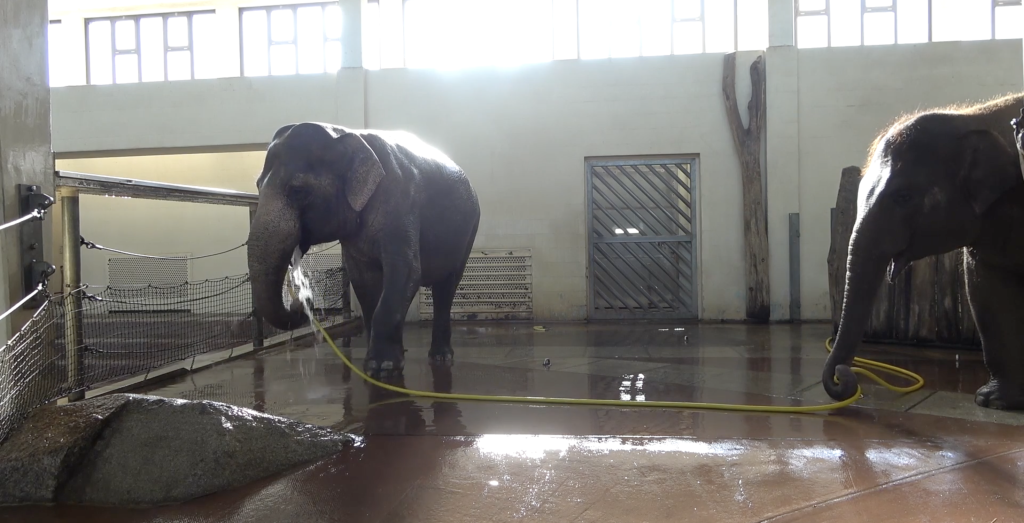
It’s a beautiful Friday in autumn and I am here to share some drama with all of you: the story of two big, beautiful female elephants whose long-simmering resentments boiled over into an all-out brawl over one of the most coveted gadgets (by pachyderm standards). Our story takes place at the Berlin Zoo, and names have not been anonymized to bring you the cold, hard truth of what can happen when two divas have a trunk-off.
Without any further ado, let me introduce you to the Asian elephants at the heart of this story.
Mary was born wild in 1970 somewhere in India. Before she became Mary, she was known as Drumbo, a name that appears to be popular for elephants but whose etymology appears, strangely, Irish? Or maybe someone wanted to embellish Dumbo. Either way, Mary, 54, is the oldest Asian elephant at the Berlin Zoo, a position that comes with a not insignificant level of fame and power. Mary may have a big head, but she’s earned it. Mary shares her enclosure at the zoo with four other elephant: Carla, Pang Pha, Victor, and Anchali.
Anchali, 12, is the baby of the bunch and a bit of a princess. Her parents, Pang Pha and Victor, welcomed her into the world in 2012, where she made the news—wowing visitors for being simply too much of a cutie-pie. She popped out at a hefty 353 pounds and was covered in sparse, downy hair. The world, or at least Berlin, fell in love with Anchali as she stumbled around her enclosure, covered in grass from her many naps. Please enjoy the following image of Baby Anchali.
And then there is Anchali’s mother, Pang Pha. Pang Pha is most notable for going viral last year after learning how to peel her bananas. Pang Pha is picky, and will only peel bananas that are yellow-brown. Pang Pha stayed out of the feud between Mary and Anchali, perhaps occupied with her bananas.
Everything between the female elephants at the Berlin Zoo was relatively peaceful. “It is my impression that most of the time female elephants get along ok, but more problematic/aggressive interactions do occur,” Michael Brecht, a neuroscientist at Humboldt University of Berlin, wrote in an email. Brecht is an author on a new paper that describes, among other things, Mary and Anchali’s feud.
But that peace would soon be disrupted. Lena Kaufmann, a graduate student in Brecht’s lab, was at the zoo when she observed Mary showering in an unusual way. Mary, like other elephants, would shower herself by spraying water on her body with her trunk. But unlike other elephants, Mary also showered with a water hose—picking it up with her trunk and using it to shower for around seven minutes. The members of Brecht’s lab were curious, and researcher Lea Urban led the study on how the elephants at the zoo interact with the water hose.
“As it is often the case with elephants, hose tool use behaviors come out very differently from animal to animal,” Brecht said in a press release. “Elephant Mary is the queen of showering.” Mary had gotten her showers down to an art. When she wanted the 24mm hose to act as a stiff shower head, she held it right behind its tip. When she wanted to reach her back, she used the hose as a lasso, circling her body with water spray. And when the researchers offered her different types of hoses, one thinner and one thicker, Mary ignored the thickest hose and instead showered with her trunk. Who taught Mary how to shower? None of her caretakers did. But the researchers suggest Mary might find the hose intuitive, given its resemblance to her trunk.
But wait, you might be asking. So far this sounds like a feel-good story about Mary and her hose. Where is the drama, the intrigue, the tension? Great question. “When we decided to study Mary’s showering behavior she got a lot of showering time,” Brecht said, adding that as the study progressed, the researchers noticed more aggressive interactions between the elephants. “We do not know the cause for sure, but wonder if envy and the like, contributed here.”
As Mary, newly crowned as the queen of showering, luxuriated in her seven-minute showers, was Anchali green with envy? What we do know is that the younger elephant began interfering with Mary’s self-care. “It is important to know that it is quite difficult to disrupt water flow through these big showering hoses,” Brecht said. At a certain point in the research, Anchali grabbed Mary’s hose with her trunk, lifted it off the ground, and folded it, creating a kink. When Anchali squeezed this kink, she cut off Mary’s water flow. Over time, as Mary showered, Anchali got better at her five-step kinking behavior and was able to stop Mary’s water for even longer. Was Mary’s reign under attack?
The members of Brecht’s lab were stunned by this behavior, but no one agreed on exactly what it meant. They laid out the facts. “Anchali is usually not supposed to take another elephant’s hose,” Brencht said, adding that the caretakers scold her if she does. The researchers offered Anchali two hoses, one leading to Mary and one leading somewhere else, reasoning that if Anchali’s intent was sabotage, she would kink the hose leading to Mary. But in 10 of these experiments, Anchali simply kinked the hose closer to her—an unclear outcome.
Some of the researchers concluded there was not enough evidence to confirm sabotage. Perhaps Anchali was playing with the hose. And in the two-hose control test, how could the researchers be sure that Anchali knew which hose led to Mary, or was simply obeying the rules? “Given that we know that taking another elephant’s hose is usually prevented/punished by the caretakers, this is not an entirely surprising outcome,” Brecht said.
For his part, Brecht suspects it was an act of sabotage. The researchers observed “numerous aggressive acts by Mary toward Anchali,” giving the younger elephant motive. And Anchali also devised a second method to cut off Mary’s showering: squishing the hose with her trunk and then lowering her body weight on top of it, a behavior known as a trunkstand.
Brecht called it irrational to automatically assume “this was not done intentionally.” He cited this as an example of anthropodenialism, a term coined by the late primatologist Frans de Waal that refers to the instinct to reject human-like traits in other animals, or animal-like traits in people. Why should we be surprised that a young elephant might be interested in playing a little prank or doing a little revenge? “Elephants are amazing with hoses and we wonder if they play tricks on each other,” Brecht said.
For her part, Mary did not seem to understand Anchali’s behavior. When the younger elephant kinked the hose, Mary would stop showering but would not try to fix the problem. And again, Mary continued to show repeated acts of aggression toward Anchali around showertime. And somewhere, far away, Pang Pha was minding her own business, possibly thinking of bananas.
Saboteur or not, Anchali is clearly ready to recapture some of the spotlight she enjoyed in her youth. May she serve as a model for other animal child stars who may feel adrift as they age into adulthood. This is one of the great trade-offs of aging: You lose your baby fat, but you gain the fine motor skills needed for a beautiful act of revenge.







